I 10 migliori musei italiani da non perdere
Italy is renowned for its rich artistic and cultural heritage, unparalleled in the world. Each corner of the country is steeped in incredible stories, and its numerous museums serve as windows into this extraordinary legacy. Each one narrates a unique tale, revealing the artistic and historical wonders that make Italy so unique.
L’Italia vanta un patrimonio artistico e culturale tra i più ricchi e famosi del mondo. Ogni angolo di questo paese racchiude storie incredibili, e i suoi numerosi musei sono i luoghi attraverso cui possiamo ammirare questa straordinaria eredità. Ognuno ci racconta una storia diversa, svelando le meraviglie artistiche e storiche che rendono l’Italia così unica.
Attempting to rank them is challenging, as each museum shines with its own unique features and treasures. That’s why the following list of best museums in Italy is purely based on personal preference. It features a mix of the usual suspects (excluding places like Pompeii or the Colosseum, which are archaeological sites) and some lesser-known gems to enrich your travel itineraries.
Qualunque tentativo di classificarli è pressoché impossibile, poiché ogni museo ha il suo fascino speciale e custodisce tesori inestimabili. Ecco perché la seguente lista dei migliori musei italiani si basa puramente su preferenze personali. Include sia i soliti noti (lasciando fuori però luoghi come Pompei o il Colosseo, classificati come siti archeologici) sia alcune perle meno conosciute, perfette per rendere il vostro viaggio ancora più speciale.
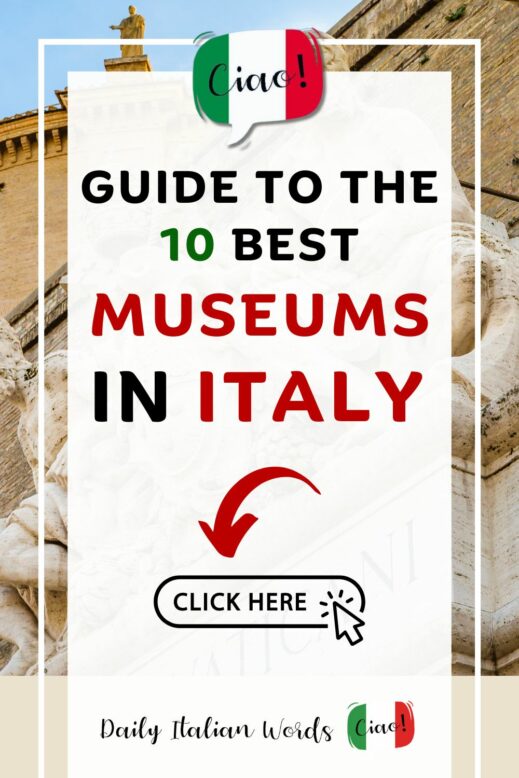
Uffizi Gallery, Florence
Galleria degli Uffizi, Firenze
Let’s start with a heavyweight – the Uffizi Gallery! Home to Botticelli’s ethereal ‘Primavera’ and countless masterpieces, the Uffizi remains one of my top museum pick in Italy to this day. It’s a place where you can immerse yourself in the works of art history’s rock stars like Botticelli, Leonardo, Giotto, and Michelangelo, all in a single day.
Iniziamo subito con un gigante del mondo dell’arte: la Galleria degli Uffizi di Firenze, ch ospita al suo interno la sublime ‘Primavera’ di Botticelli, oltre a una miriade di altri capolavori. Gli Uffizi, che continuano a essere tra i miei musei italiani preferiti, offrono l’occasione unica di immergersi nelle creazioni di veri e propri miti dell’arte, come Botticelli, Leonardo, Giotto e Michelangelo, in un’unica giornata.
Originally built in the 1500s, thanks to the Medici family (huge art enthusiasts, by the way), the Uffizi were originally meant for boring paperwork and court stuff. But their true calling was to become the home of some of the most beautiful paintings and sculptures from the Middle Ages to modern times, with a special focus on the artistic achievement during the Renaissance.
Costruita nel XVI secolo per volontà dei Medici (grandi appassionati d’arte), la Galleria degli Uffizi fu inizialmente concepita per la gestione di noiose attività burocratiche e giudiziarie. Ma il suo destino era ben diverso: diventare la casa di alcune tra le più straordinarie opere pittoriche e scultoree dal Medioevo fino all’era moderna, con particolare attenzione alla produzione rinascimentale.
One of my favorite pieces is Judith Beheading Holofernes by Artemisia Gentileschi. She was the first woman to be admitted to Florence’s illustrious Academy of the Arts of Drawing and her story is truly inspiring.
Una delle mie opere preferite è “Giuditta decapita Oloferne” di Artemisia Gentileschi. Lei fu la prima donna ad essere ammessa nell’illustre Accademia delle Arti del Disegno di Firenze e la sua storia è fonte di grande ispirazione.
Read more: uffizi.it/en
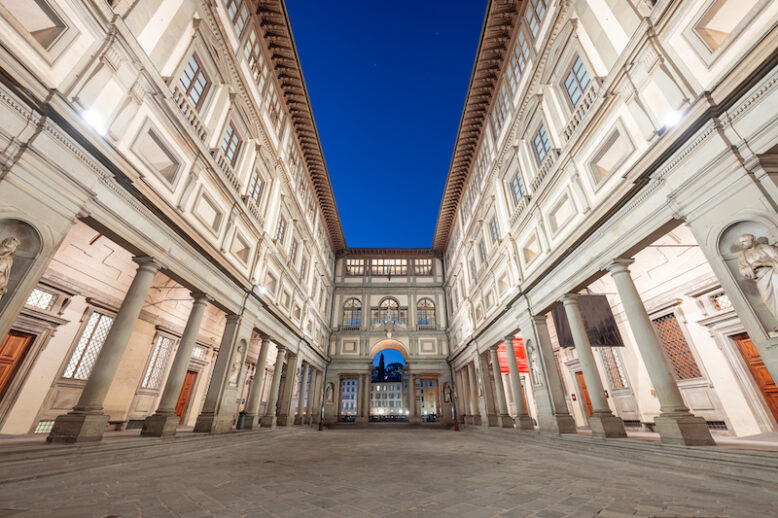
Accademia Gallery, Florence
Galleria dell’Accademia, Firenze
Let’s remain in Florence for another great museum, the Accademia Gallery, where you can see the colossal figure that Michelangelo sculpted from a single block of Carrara marble – the David. Two artists before him had attempted and failed to bring this marble to life, but it was Michelangelo who transformed it into a breathtaking 5-meter-tall David, celebrated for its anatomical perfection.
Sempre a Firenze troviamo un altro imperdibile museo, la Galleria dell’Accademia, dove si può ammirare la colossale figura scolpita da Michelangelo da un unico blocco di marmo di Carrara – il David. Prima di lui, altri due artisti avevano tentato invano di plasmare questo marmo; tuttavia, fu Michelangelo a trasformarlo nel David, un’incredibile opera alta ben cinque metri, celebrata per la sua straordinaria perfezione anatomica.
Contrary to popular belief, the David is not the sole treasure of the Accademia Gallery. The museum also exhibits the artist’s fascinating unfinished statues and the preparatory model of Giambologna’s ‘The Rape of the Sabine Women,’ celebrated for its dynamic spiral structure. Additionally, it features an array of prestigious paintings by illustrious artists like Giotto, Paolo Uccello, Botticelli, Ghirlandaio, and Filippino Lippi.
Contrariamente a quanto molti credono, il David non è l’unica meraviglia ospitata all’interno della Galleria dell’Accademia. Il museo espone anche le affascinanti statue incompiute di Michelangelo, il modello preparatorio del ‘Ratto delle Sabine’ di Giambologna, celebre per la sua dinamica struttura a spirale, e una serie di prestigiosi dipinti di illustri artisti come Giotto, Paolo Uccello, Botticelli, Ghirlandaio e Filippino Lippi.
A personal favorite of mine is a meticulously detailed panel from a wedding chest, crafted by Masaccio’s brother (the “Cassone Adimari”), which portrays a Florentine wedding procession so vividly, it nearly mirrors a photograph.
Una delle mie opere preferite è un pannello dipinto che faceva parte di un cassone nuziale (il “Cassone Adimari”), opera del fratello di Masaccio. Ritrae un corteo nuziale fiorentino con una tale precisione di particolari da sembrare quasi una fotografia.
Read more: galleriaaccademiafirenze.it/en
Museum of the Treasury of San Gennaro, Naples
Museo del Tesoro di San Gennaro, Napoli
The Museum of the Treasury of San Gennaro is a special destination, essential to understand a key aspect of Neapolitan culture: the deep devotion to the city’s patron saint. It houses a remarkable collection of silverware and jewelry, considered one of the world’s most precious, gifted over centuries by monarchs, Popes, and notable figures in honor of the Saint.
Il Museo del Tesoro di San Gennaro è un luogo speciale da visitare per comprendere davvero un aspetto fondamentale della cultura di Napoli: l’intensa devozione per il proprio santo patrono. Esso custodisce una straordinaria collezione di argenti e gioielli, tra le più preziose a livello mondiale, frutto delle tante donazioni con cui nel corso dei secoli re, Papi e personalità illustri hanno omaggiato San Gennaro.
These pieces are not just economically valuable but also artistically significant, crafted by renowned artisans from the famous Neapolitan goldsmith school. Just to give you an idea, between the 1600s and 1800s the Neapolitan goldsmith workshops produced about 70% of Europe’s silver works!
Le opere presenti in questa collezione non possiedono solo un inestimabile valore economico, ma hanno anche una profonda importanza artistica, in quanto furono realizzate dai maestri artigiani della celebre scuola napoletana di oreficeria. Solo per darvi un’idea dell’importanza di questa scuola, si stima che tra il XVII e il XIX secolo, le botteghe orafe di Napoli abbiano realizzato circa il 70% delle opere in argento presenti in Europa.
Highlights at the museum include the gilded silver mitre, embellished with 3692 rubies, emeralds, and diamonds, and the necklace of San Gennaro, featuring large gold links with sapphire and emerald stones and enriched with jewels donated through the years, including a precious cross gifted by Napoleon’s brother. The saint’s treasure also includes contributions from ordinary citizens, like a pair of pearl earrings donated by a woman who survived the 1884 cholera epidemic.
Tra le opere più preziose spiccano la mitra in argento dorato impreziosita da 3692 gemme tra rubini, smeraldi e diamanti, e la collana di San Gennaro, formata da grandi maglie d’oro adornate con zaffiri ed smeraldi, oltre a numerosi gioielli donati nel tempo. Tra questi, anche una preziosa croce offerta dal fratello di Napoleone. Ma il tesoro di San Gennaro comprende anche donazioni da parte di cittadini comuni, come un paio di orecchini di perle che furono donati al santo da una donna sopravvissuta all’epidemia di colera del 1884.
Read more: tesorosangennaro.it/en
Egyptian Museum, Turin
Museo Egizio, Torino
And now let’s embark on an Indiana Jones-style adventure at the Egyptian Museum in Turin’s historic center, renowned as the world’s oldest museum dedicated exclusively to the art and culture of ancient Egypt. Its beginnings can be traced to a single bronze slab inscribed with hieroglyphics, acquired by Carlo Emanuele I of Savoy in 1626. Over centuries, the Savoy’s collection expanded, establishing the museum as the second most significant Egyptian repository globally, surpassed only by Cairo’s collection.
E ora imbarchiamoci in una avventura in puro stile Indiana Jones al Museo Egizio nel cuore del centro storico di Torino, riconosciuto come il più antico al mondo interamente dedicato all’arte e alla cultura dell’antico Egitto. La sua storia affonda le radici in una lastra di bronzo incisa con geroglifici, acquisita nel 1626 da Carlo Emanuele I di Savoia. Nel corso dei secoli, la collezione Savoia si arricchì notevolmente, evolvendo in un museo che è diventato il secondo più importante a livello mondiale dopo quello del Cairo.
The museum boasts a collection of remarkable artifacts, including the Mummy of Gebelein, a symbol of ancient Egyptian embalming expertise, and the Book of the Dead of Iuefankh, an extensive 19-meter-long papyrus scroll, which served as a guide for the deceased through the afterlife, in accordance with ancient Egyptian funerary traditions.
Tra le sue collezioni spiccano reperti di straordinaria importanza, come la Mummia di Gebelein, testimone dell’arte dell’imbalsamazione dell’antico Egitto, e il Libro dei Morti di Iuefankh, un lungo rotolo di papiro di 19 metri, utilizzato come guida spirituale per i defunti nell’oltretomba, seguendo le antiche usanze funerarie egizie.
Don’t miss the Gallery of Kings, a mesmerizing, a dimly lit space designed by Oscar-winning Dante Ferretti featuring magnificent statues of sphinxes, deities, and pharaohs, including the famous Tutankhamun and Ramses II.
Da non perdere la Galleria dei Re, uno spazio suggestivo progettato dal premio Oscar Dante Ferretti, dove una luce soffusa incornicia magnifiche statue di sfingi, divinità e faraoni, tra cui i famosi Tutankhamon e Ramses II.
Read more: museoegizio.it/en

Vatican Museums, Rome
Musei Vaticani, Roma
No list of best museums in Italy is complete without mentioning the Vatican Museums. Started by Pope Julius II in the 1500s, these museums have one of the world’s biggest art collections. We’re talking about 8 kilometers of hallways filled with an incredible 70,000 artworks collected by different Popes over time (yep, Popes, too, really like art!).
Nessuna lista dei migliori musei italiani sarebbe completa senza citare i Musei Vaticani. Fondati da Papa Giulio II nel 1500, questi musei custodiscono una delle collezioni artistiche più imponenti al mondo. Parliamo di 8 chilometri di corridoi e ben 70.000 opere d’arte, accumulate dai diversi Papi nel corso dei secoli (ebbene sì, anche i Papi hanno un debole per l’arte!).
The big star is the Sistine Chapel, boasting over 1000 square meters of jaw-dropping frescoes. But other incredible highlights include the Tapestry Gallery, the Gallery of Maps with its beautiful 16th-century maps of Italian regions, and Raphael’s stunning frescoes in Pope Julius II’s private apartments.
Il principale gioiello di questa straordinaria collezione è la Cappella Sistina, con i suoi oltre 1000 metri quadrati di affreschi che tolgono il fiato. Da non perdere anche la Galleria degli Arazzi, la Galleria delle Mappe con le sue bellissime mappe cinquecentesche delle regioni italiane, e i meravigliosi affreschi di Raffaello negli appartamenti privati di Papa Giulio II.
Here’s a fun fact: the Sistine Chapel is Michelangelo’s crowning achievement, even though he wasn’t keen on painting it at first, favoring sculpting instead. Nevertheless, he accepted the challenge and crafted an iconic masterpiece. His approach was revolutionary, transforming the conventional image of God to a Zeus-like figure with a white beard, setting a new standard for depicting the divine.
Ecco una curiosità: la Cappella Sistina è considerata il capolavoro di Michelangelo, ma inizialmente l’artista si mostrò alquanto riluttante poiché più incline alla scultura. Ma accettò la sfida e realizzò un’opera straordinaria, rompendo con le convenzioni dell’epoca. Rivoluzionò infatti l’immagine di Dio, rappresentandolo per la prima volta come una figura simile a Zeus, con la barba bianca, stabilendo così un nuovo standard per la rappresentazione divina.
Read more: museivaticani.va/content/museivaticani/en
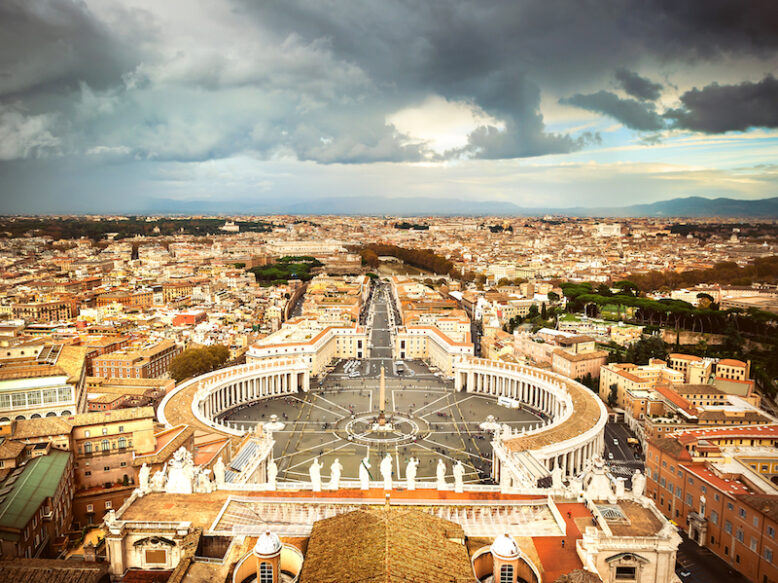
Strada Nuova Museums, Genoa
Musei di Strada Nuova, Genova
The Strada Nuova Museums represent Genoa’s premier monumental and exhibition complex focusing on ancient art. This museum route connects three palace-museums along Via Garibaldi, the new street (hence the name “strada nuova”) established as a residential area for the city’s aristocracy in the 16th century when Geova was a maritime superpower. The three palaces – Palazzo Rosso, Palazzo Bianco, and Palazzo Doria-Tursi – were once part of the Rolli system, a catalog of the city’s most prestigious buildings that were used to accommodate distinguished visitors in 16th-century Genoa – a unique model of public hospitality that became a UNESCO World Heritage Site in 2006.
I Musei di Strada Nuova rappresentano il principale complesso monumentale ed espositivo di Genova focalizzato sull’arte antica. Si tratta di un percorso museale che unisce tre storici palazzi-musei posti lungo Via Garibaldi, la ‘strada nuova’ istituita come quartiere residenziale dell’aristocrazia genovese nel XVI secolo, quando Genova era una potenza marittima. I tre palazzi – Palazzo Rosso, Palazzo Bianco e Palazzo Doria-Tursi – facevano parte del sistema dei Rolli, un elenco dei più prestigiosi edifici cittadini usati per ospitare visitatori illustri nel XVI secolo a Genova – un modello di ospitalità pubblica così innovativo da essere riconosciuto come Patrimonio dell’Umanità dall’UNESCO nel 2006.
Inside these palaces, you’ll find opulent salons adorned with frescoes and masterpieces by renowned artists such as Caravaggio, Guercino, Rubens, and Van Dyck. The interiors also feature period furnishings and secret gardens, offering a glimpse into the lavish lifestyle of Genoa’s past aristocracy. A highlight not to be missed is the Miradore atop Palazzo Rosso, providing spectacular city views.
All’interno di questi palazzi, vi attendono sontuose sale decorate con affreschi e opere di artisti del calibro di Caravaggio, Guercino, Rubens e Van Dyck. Si possono ammirare anche arredi d’epoca e giardini segreti con cui immergersi nell’opulenza dell’aristocrazia genovese di un tempo. Da non perdere il Mirador in cima al Palazzo Rosso, da cui si gode di una vista panoramica mozzafiato sulla città.
Each year, during the Rolli Days, additional sites pertaining to the Rolli lists, usually closed to the public, are opened. Keep an eye on the official website for these special events.
Ogni anno, durante i Giorni dei Rolli, vengono aperte al pubblico ulteriori dimore storiche appartenenti alle liste dei Rolli, normalmente non visitabili. Tenete d’occhio il sito web ufficiale per non perdere questa occasione.
Read more: museidigenova.it/en/strada-nuova-museums
The Doge’s Palace, Venice
Palazzo Ducale, Venezia
Speaking of maritime superpowers, it’s impossible not to mention Venice, whose historical and cultural sites rightfully deserves a distinguished spot among the best museums in Italy. Selecting just one site was pretty challenging, but ultimately, I have chosen the Doge’s Palace, the symbol of the power and splendor of the Serenissima.
Parlando di potenze marittime, è impossibile non menzionare Venezia, una città i cui siti storici e culturali meritano un posto d’onore tra i migliori musei italiani. Sceglierne solo uno è stato difficile ma alla fine ho deciso di inserire Palazzo Ducale, il simbolo della potenza e dello magnificenza della Serenissima.
Constructed in the 9th century, the Ducal Palace initially served as the residence of the doge (Venice’s chief magistrate) and the administrative epicenter of the Venetian Republic. This imposing Gothic building has seen numerous expansions and refurbishments throughout its history. It’s halls are a celebration of Venice’s glorious past, boasting invaluable masterpieces by the likes of Titian, Tiepolo, Veronese, and Tintoretto.
Costruito nel IX secolo, il Palazzo Ducale era la dimora del doge e il centro amministrativo della Repubblica di Venezia. Questo imponente edificio gotico è stato oggetto di numerose espansioni e ristrutturazioni nel corso dei secoli. Le sue sontuose sale sono un inno al glorioso passato di Venezia, arricchite con opere d’arte di inestimabile valore firmate da maestri come Tiziano, Tiepolo, Veronese e Tintoretto.
Visiting the Doge’s Palace also offers the unique opportunity to traverse the iconic Bridge of Sighs, which leads to the ancient prisons. These cells once confined many notable figures, including the famous Casanova, renowned for his audacious escape.
La visita al Palazzo Ducale regala anche l’opportunità di attraversare l’iconico Ponte dei Sospiri, che collega il palazzo alle antiche prigioni. Queste celle hanno ospitato molte figure di rilievo, tra cui il famoso Casanova, celebre per la sua audace evasione.
Read more: palazzoducale.visitmuve.it/en
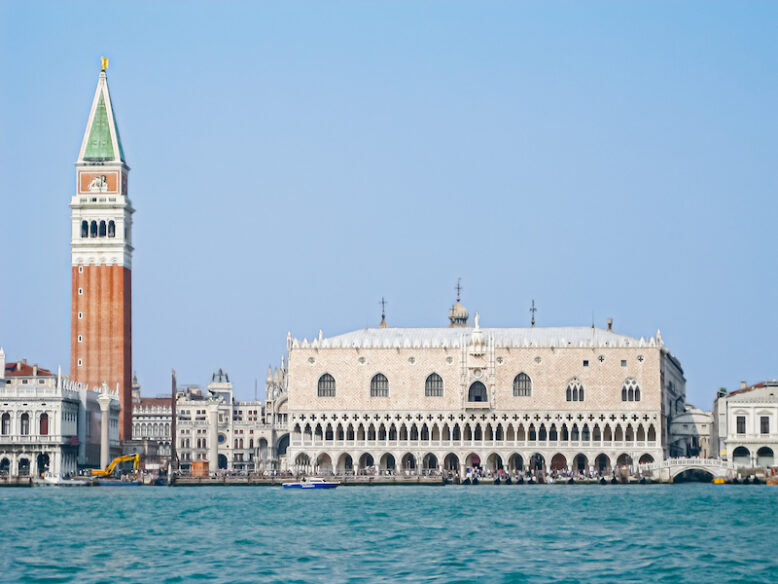
National Museum of Science and Technology, Milan
Museo Nazionale della Scienza e della Tecnologia, Milano
For curious minds and science buffs, Milan’s National Museum of Science and Technology is a great destination to explore the marvels of human scientific and technological achievements And even if you’re not a science geek, trust me, the museum’s collection will mesmerise you – think rare trains, submarines, space stations, and much more!
Per le menti curiose e gli appassionati della scienza, il Museo Nazionale della Scienza e della Tecnologia di Milano rappresenta è una splendida meta in cui esplorare i frutti del progresso scientifico e tecnologico dell’umanità. Credetemi, anche chi non nutre particolare interesse per la scienza resterà affascinato dalla straordinaria collezione del museo – che contiene tra le altre cose treni rari, sottomarini, stazioni spaziali e molto altro!
Established in 1953 within a 16th-century monastery, it stands as Italy’s largest museum dedicated to science and technology and ranks among the world’s most important ones. It’s appropriately named after the legendary Leonardo Da Vinci, and, as a nod to his genius, features a dedicated section showcasing his revolutionary inventions. And here’s a fun fact: it’s the proud home to the only lunar fragment in Italy!
Fondato nel 1953 all’interno di un monastero del XVI secolo, questo è il più grande museo italiano dedicato alla scienza e alla tecnologia e figura tra i più prestigiosi a livello mondiale. Il suo nome è un omaggio al leggendario Leonardo Da Vinci e, in onore del suo genio, ospita una sezione interamente dedicata alle sue rivoluzionarie invenzioni. E a proposito di curiosità interessanti, il museo è anche sede dell’unico frammento lunare visibile in Italia!
Read more: museoscienza.org/en

Palazzo Te, Mantua
Palazzo Te, Mantova
The palace of the Gonzaga family in Mantua houses one of the most incredible works I have ever seen: the “Fresco of the Giants” by Giulio Romano, a student of Raphael, which is considered a pivotal piece of Italian artistic heritage.
Il palazzo della famiglia Gonzaga a Mantova custodisce una delle opere d’arte più incredibili che abbia mai visto: l’affresco dei giganti di Giulio Romano, allievo di Raffaello, considerato un capolavoro del patrimonio artistico italiano.
Trust me, this isn’t just another fresco in a historical palace. Here, Giulio Romano masterfully employs perspective illusionism to break free from the room’s physical limits, plunging us straight into the heart of an epic scene. The fresco depicts an episode straight out of Ovid’s Metamorphoses, where Jupiter punishes the giants for their bold attempt to overthrow the gods and seize control of Olympus.
Credetemi, non si tratta semplicemente dell’ennesimo affresco in un palazzo storico. Qui, Giulio Romano sfrutta magistralmente l’illusione prospettica per superare i confini fisici della stanza, catapultandoci direttamente nel cuore di una scena epica. L’affresco raffigura infatti un episodio tratto dalle Metamorfosi di Ovidio, in cui Giove scatena la giustizia divina contro i giganti che hanno assalito l’Olimpo, cercando di prendere il posto degli dei.
Imagine walking into the room and finding yourself in the midst of tumbling mountains, crumbling palaces, and giants crushed by stones and columns. It’s like stepping into a 3D movie, with every detail jumping out at you. A sensation perfectly described by Vasari when he wrote that “whoever enters that room, cannot help but fear that everything will collapse on them.”
Immaginate di varcare la soglia della stanza e ritrovarvi circondati da montagne che si sgretolano, palazzi che crollano e giganti schiacciati da massi e colonne. È come entrare in un film tridimensionale, con dettagli che prendono incredibilmente vita dinanzi a noi. Vasari non poteva trovare parole migliori per descrivere questa sensazione quando scrisse che “chi entra in quella stanza, non può non temere che ogni cosa non gli rovini addosso.”
Read more: centropalazzote.it/language/en/fondazione-palazzo-te
National Museum of Cinema, Turin
Museo Nazionale del Cinema, Torino
Another top museum in Italy, and a personal favorite of mine, is the National Museum of Cinema in Turin. Unique in Italy and among the world’s most significant due to its rich collection, it offers a comprehensive journey through the history of cinema, spanning from the early days of shadow theater to the cutting-edge special effects of modern times.
Un altro dei migliori musei italiani, e uno dei miei preferiti, è il Museo Nazionale del Cinema di Torino. Unico nel suo genere in Italia e tra i più significativi al mondo grazie alla sua straordinaria collezione, offre un viaggio avvincente attraverso la storia del cinema, dalle prime rappresentazioni del teatro delle ombre agli innovativi effetti speciali dell’epoca moderna.
The idea for a museum dedicated to cinema came to Maria Adriana Prolo, a famous cinema historian, in 1941. Today, the museum houses an impressive array of rare photographs, vintage posters, advertising materials, filmmaking equipment, iconic costumes, and original set pieces like the original Darth Vader helmet and the menacing shark head from Steven Spielberg’s “Jaws.”
L’idea fu di Maria Adriana Prolo, una rinomata storica del cinema che nel nel 1941 decise di dar vita a un museo dedicato al cinema. Oggi, il museo ospita una sorprendente varietà di fotografie rare, manifesti d’epoca, materiale pubblicitario, attrezzature per la produzione cinematografica, costumi e scenografie originali. Tra i pezzi iconici, il casco originale di Darth Vader e la minacciosa testa di squalo dal film “Lo Squalo” di Steven Spielberg.
The National Museum of Cinema is located in the Mole Antonelliana, the symbol of of Turin, where you can can ascend to a panoramic terrace via a transparent crystal elevator.
Il Museo Nazionale del Cinema si trova all’interno della Mole Antonelliana, simbolo di Torino, dove è possibile prendere un ascensore trasparente in cristallo raggiungere una splendida terrazza panoramica.
Read more: museocinema.it/en
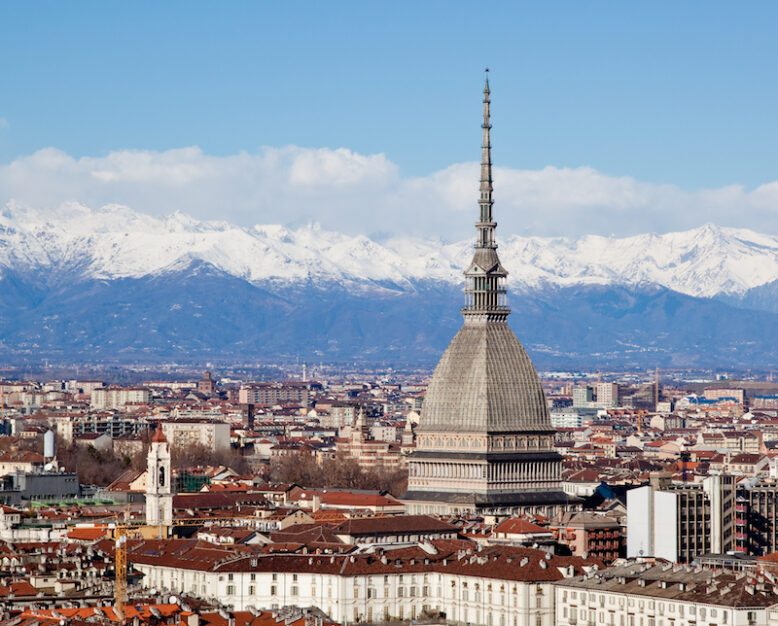
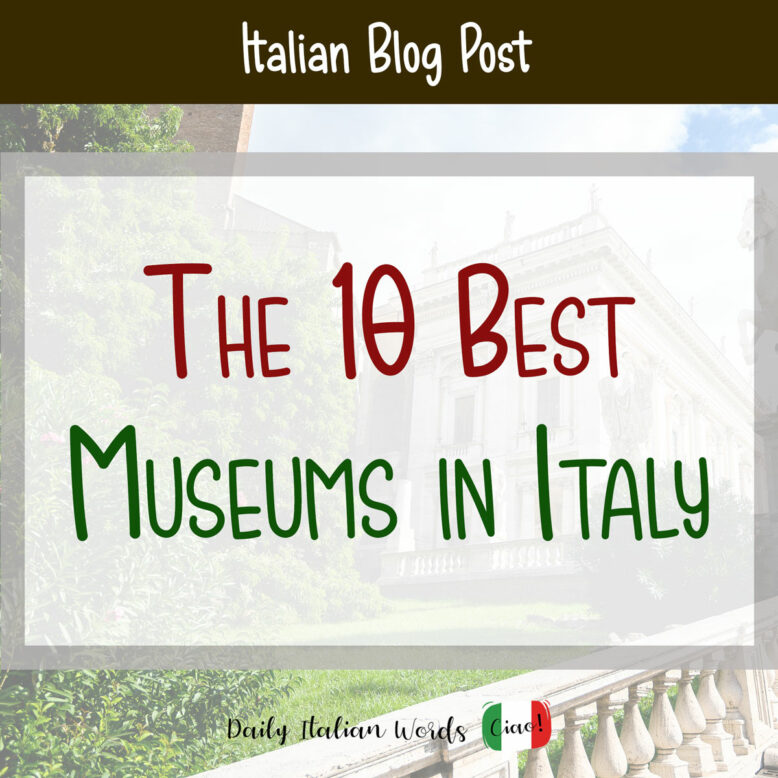

Valentina Nicastro is a travel writer in love with her home country, Italy. Having travelled widely around the globe, she realised there was more to explore closer to home and decided to put the passport aside for a while. When she is not immersed in documenting Italy, you’ll find her donning her communication consultant hat, weaving words as a content writer and bridging linguistic divides as a translator.


